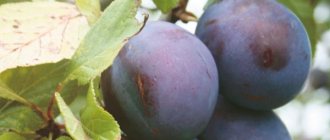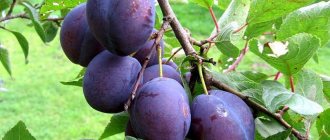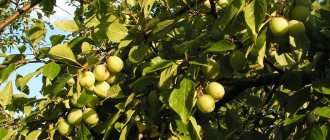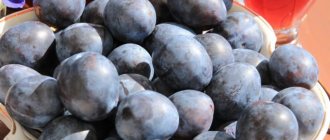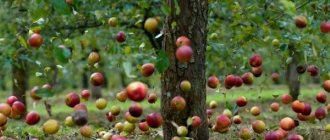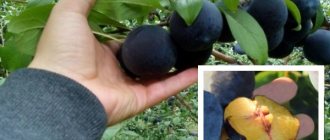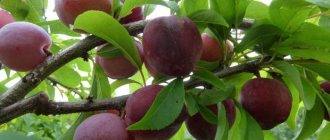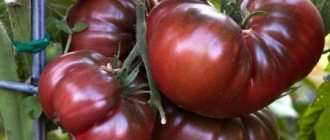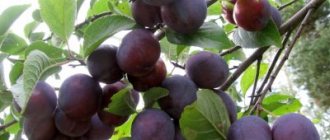The large and beautiful yellow plum is valued for its sweet, slightly sour taste. The main difference is, of course, the beautiful amber or golden hue. As for agricultural technology, there is one important nuance. Most varieties and hybrids are the result of many years of breeding work, when wild forms and cherry plums were crossed. As a result, this made it possible to achieve a subtle sweet taste with sourness due to the high content of ascorbic acid, resistance to frost or drought, and other unfavorable conditions. But precisely because of their origin, many of them cannot pollinate on their own.
Features of yellow plum varieties
There are many varieties of this crop and almost every year breeders develop new hybrids. They can be divided into several groups. So, there are self-fertile varieties. They produce crops on their own and do not require pollinators. However, despite all the advantages in terms of productivity, they are inferior to self-sterile varieties. On the latter, fruits are formed only if other plum crops grow nearby, which act as a pollinator. Therefore, it is important that trees grow on the site that will bloom at the same time as self-sterile crops.
Important! When choosing a suitable option, you should analyze parameters such as frost resistance, yield, fruit characteristics, etc.
For example, gardeners are often interested in a variety of small, round, golden-colored plums. It could be Altai Jubilee, Morning or Tatar Yellow. But of the listed options, only the first is universal, the rest have less frost resistance.
One of the best table varieties is the yellow plum Voskhod , bred on the basis of Renklod. These are fruits of greenish-yellow color with crimson splashes, covered with a bluish coating. Characteristics of this variety:
- high yield: on average, a six-year-old tree bears 49-50 kg of fruit. Moreover, it begins to bear fruit at the 4th year, sometimes at the 5th year. These fruits (and from a biological point of view, drupes) with a fairly dense skin and a small and easily separated stone appear in August. They are large, weighing up to 42-45 g;
- excellent taste: the pulp is juicy, sweet and sour;
- frost resistance.
The Khopta plum cannot boast of such large fruits. It bears small fruits weighing up to 20 g. But these plums have a pleasant sweet and sour taste. Their skin is thin and greenish-yellow in color. The stone is large and easily separated from the pulp. Yellow plum variety Khopta is a so-called self-sterile crop. This means that it must be fertilized at the expense of other plum trees. For these purposes, a variety with the same flowering period as Khopta is suitable. Among its positive characteristics are:
- excellent taste;
- the possibility of obtaining the first harvest within 3-4 years from the moment the tree is planted;
- good yield: up to 20 kg per tree;
- relatively high frost resistance, although the buds that appear in May do not tolerate frost well.
Mountain yellow plum is a mid-season variety. Ripens in the second half of August. The fruits are beautiful, large (24-25 g, but sometimes more), the pulp is sweet. The skin color of the fruit is light yellow. Among the characteristics of the Mountain yellow plum are the following:
- high winter hardiness, due to which it is suitable for cultivation in the Urals and Altai Territory;
- high yield (plum is also considered self-sterile, but in the presence of a pollinator it can produce up to 40 kg from one tree).
Note! The small Altai jubilee plum is considered an excellent pollinator in itself. It can be grown next to the varieties described above. Its fruits are small, rarely weighing more than 16 g, but their taste is very pleasant. The color is yellow, and on the sunny side it is reddish with a noticeable waxy coating. Productivity, although high, is irregular.
The Yantarnaya Mlievskaya plum has good performance . This variety was bred in Ukraine and is suitable for the southern regions because it is heat-loving. This is a self-fertile crop; it needs a good pollinator. But if it is there, then you can get a very high yield. It is considered a large-fruited variety, and these fruits are juicy, bright yellow, truly amber in color. The weight of one piece can be up to 70 g. Its features also include:
- very sweet taste with a subtle grape undertone. This type is considered by many to be the best for making jam, since ripe fruits contain a lot of pectin;
- good winter hardiness (it may not tolerate severe frosts, but moderate cold will not harm);
- early fruiting, since the first fruits on such a tree appear already 2 years after planting;
- high yield: 1 mature tree can produce up to 50 kg of plums.
In addition, it demonstrates good drought resistance. Another variety has a similar advantage - the Honey yellow plum (popularly referred to as the White Honey plum). It was bred in the Donetsk region, and therefore the breeders were faced with the task of breeding a drought-resistant species. In Russia it is grown in the Central Black Earth Region. Practice shows that Honey can be grown further north, but this requires the correct frost-resistant rootstock. Then you can plant it in the Moscow region and in the northwestern regions.
This is an early variety, the fruits appear already in July. The tree is classified as self-sterile and requires good pollinators. Among the positive qualities of Honey Yellow, we can highlight large fruits - up to 50 g in weight and high yield (40-80 kg per tree, depending on the area of growth).
Yellow Mountain Plum
large Golden plum also belongs to heat-loving varieties . It is grown mainly in the Lower Volga region, since it does not tolerate frost well. The main difference of the variety is its partial self-fertility. The harvest is relatively small: maximum - 30 kg per tree. But the fruits have a pleasant sweet and sour taste, a beautiful light yellow hue and a fairly thick skin. You can even leave them in the refrigerator to ripen. Shelf life - 1.5 months.
The most frost-resistant is the Canadian plum . It differs from European varieties in the number of chromosomes. This is a species bred to grow in harsh conditions. Trees can withstand frosts down to −50°C. It blooms in May, but later than other plums, so the buds are not afraid of frost. Belongs to the category of self-sterile plants.
Important! Several different varieties of this species have been developed, which may differ in yield.
There is another very interesting variety - yellow egg plum . Basically it has value as a rarity. The variety was first described in 1676, that is, it is one of the oldest. Its fruits are quite large, the yield is high - up to 40 kg per tree. But this variety is more interesting to collectors and enthusiasts, since the taste of the fruit is sour, the stone is difficult to separate, the bright yellow skin is thin, and these fruits simply cannot be stored for a long time when fresh. But this tree is resistant to both frost and drought. It begins to bear fruit only 6-7 years after planting. You can use the fruits to make marshmallows and compotes.
Plum Renclod early yellow
An early-ripening, early-fruiting, high-yielding variety of domestic plum; fruit ripening occurs in the second half of July - early August.
The tree tolerates harsh winters well, is resistant to drought and major diseases, and is undemanding in care.
Tree up to 5 m high, with a spherical, not too dense crown.
The variety is self-sterile and requires nearby pollinating trees (the best options are the varieties Vengerka Donetskaya, Vengerka early, Renklod Karbysheva).
The fruits are round, slightly flattened, weighing 40-55 g. The skin is dense, yellow with a clear greenish tint and a white waxy coating, sometimes with a golden-orange blush, easily removed. The pulp is sweet, aromatic, very juicy, “transparent”, with a honey flavor, greenish-yellow in color. The bone is difficult to separate from the pulp.
The fruits are quite dense and transport well. Used fresh, suitable for processing.
Features of agricultural technology
The rules for caring for this crop largely depend on what variety the gardener is dealing with in this case. But there are also rules common to all varieties.
So, theoretically, plum trees can be planted in spring or autumn. In the conditions of central Russia, there is always a risk that the seedlings will not have time to take root during autumn planting, and then they will simply freeze out in the winter. Therefore, it is still recommended to do this in the spring, preparing holes about 60 cm deep 2 weeks before planting. There is no need to plant deeper, otherwise the tree bark will dry out, its growth will be suppressed and the yield will decrease. The soil that is removed from these depressions is mixed with humus and poured back into the hole. The seedling is tied to a wooden peg hammered side by side.
Important! The drain does not require complex maintenance. In the first year, you need to prune, following the tiered pattern and leaving 40 cm between the branches. In the future, only dry and damaged ones will need to be removed, then the tree will bear fruit for a long time.
The soil around the tree needs to be loosened regularly, and fertilizers must be applied on time using mineral compounds. You definitely need to do this in May, during the flowering period. Organic fertilizers are applied to the soil twice a year. Humus and compost give good results, but fresh manure is contraindicated for trees.
Care
For the successful cultivation of the Black Ambler variety and its abundant fruiting, it is necessary to adhere to certain rules of care.
Watering
This diploid plum requires regular watering during dry periods, but does not tolerate prolonged stagnation of moisture in the soil. especially important at the stage of budding, flowering and ovary formation .
It is recommended to limit watering during fruiting, as this can lead to watery and cracking plums. The recommended frequency of watering for this variety is once every 2 weeks at the rate of 30-60 liters per tree.
Top dressing
It is recommended to start feeding plum trees in the second year after planting. At the beginning of the growing season, you need to use urea at the rate of 30-60 g per bucket of water. Black Ambler should be fertilized a second time after flowering, using chicken manure 1:15 or mullein 1:10.
The third feeding for cherry plum is recommended during the formation of the ovary. During this period, it is important to use superphosphate 40-70 g and potassium sulphide 25-50 g per bucket of water.
Fertilizers can be applied with dry granules into the root circle , followed by embedding them in the soil and watering.
Trimming
For this fruit tree, formative spring pruning is extremely important to achieve maximum yield.
Therefore, when planting, it is necessary to shorten the main conductor to a height of 60-80 cm , as well as side shoots, if present, to a length of 15-20 cm.
Over the next two years, you need to select 2-3 strong branches, which will make up the first and second tier.
also need to shorten the main conductor annually so that its growth point is 20 cm above the uppermost side shoots. Between branches of different tiers there should be a distance of 20 cm along the trunk.
In the third year of formative pruning, you need to select one side branch and remove the rest. It will make up the third tier of the tree. It is recommended to leave shoots whose angle of departure from the trunk is 30-45 degrees. When forming the skeleton of a tree, it is necessary to promptly remove all unnecessary branches, cutting them into a ring. After pruning, the wounds should be treated with garden varnish.
It is also recommended to periodically clean the tree crown from broken and damaged branches. Sanitary pruning can be carried out in the spring before the growing season begins and in the fall after it ends. As the tree grows, young shoots appear at its base that need to be removed. This must be done in early spring.
Caring for cherry plum involves loosening the soil in the root circle and removing growing weeds. Carry out the procedure throughout the season as needed.
The first three years after planting in the central and northern regions, cherry plum seedlings need to be insulated for the winter. To do this, it is recommended to lay mulch from humus in a layer of 5 cm in the root circle, and wrap the crown with agrofibre.
Advantages and disadvantages of yellow plum
The varieties listed above have an important advantage - high yield. But many have other advantages and disadvantages. Thus, the Altai jubilee yellow plum was bred from Chinese varieties. Like many Far Eastern species, it is not suitable for the climatic conditions of Central Russia. But the variety has its advantages. In addition to very tasty fruits, it is also resistant to diseases, in particular to hole spot.
The Amber plum described above has the same advantage. It is very resistant to classic stone fruit diseases, but has another drawback. If plums are fully ripe, they will not be stored for long due to the skin on the fruit being too thin. Therefore, it is recommended to harvest the crop in a slightly unripe state.
Important! Such fruits can be kept in the refrigerator for a long time, where they gradually reach the desired condition.
The Honey Yellow Plum is close in many characteristics to the variety described above. However, the fruits have a higher shelf life, so they can be easily transported. The only drawback of the variety is its tallness. This means that such a tree requires more attention. In the spring, pruning must be done, otherwise in a few years there will be no fruit on the low-growing branches.
Thus, before choosing a variety for planting, you need to carefully read the descriptions, compare different options based on basic indicators, and also study the rules of care. This will help you understand what you can expect from a particular variety of yellow plum.
Plum is a fastidious garden crop, the yield of which largely depends not only on proper care, but also on the climate in the region. Breeders are constantly working to improve the productive properties of this plant.
Thanks to the systematic crossing of cherry plums, as well as Chinese and domestic plums, a hybrid was obtained, characterized by improved yield, cold resistance and taste. In this article we will look at the most common and best varieties of yellow plums.
Diseases and pests
The diploid Black Amber plum has high natural immunity and is therefore not susceptible to common diseases and crop pests. But if the growing and care conditions do not match, its stability decreases.
Possible problems:
Powdery mildew .
The disease develops at high humidity and high temperature. When infected, a white coating appears on the leaves, which subsequently turns brown.This leads to disruption of the photosynthesis process. To combat it, it is recommended to treat the tree with Skor or Topaz.
- Cladosporiosis . Infection is possible throughout the warm period of the year. The disease manifests itself as reddish-brown elongated spots on young shoots and leaves. If signs appear, it is recommended to cut off the affected areas and burn them, and treat the tree with Bordeaux mixture.
- Ticks and fleas . If pests appear, tree growth slows down, leaves become deformed, flowers and ovaries fall off. For the fight it is recommended to use Actellik, Fufanon.
Altai Yubileinaya
The most common mid-early variety of yellow plum, which can be found in cold regions. Thanks to its frost resistance, it can be grown even in the conditions of Eastern Siberia and northern Kazakhstan. The hybrid was developed by crossing highly productive varieties of traditional plums - Manchurian Prune and Immunnaya.
The tree is medium-sized, has a pyramidal crown with medium volume of foliage. The branches are brown, the stem is low. Large shoots form characteristic protruding buds, which contain 2-3 white flowers that bloom before the leaves.
Fruiting occurs only 3-4 years after planting an annual plant. The fruits ripen in the middle and by the end of the third ten days of August. Productivity is high (up to 40 kg per tree), but if care conditions are not followed, it can be irregular. Self-sterile type of pollination.
The small fruits are round in shape with slight angularity and a pronounced furrow. The color is rich orange-yellow with some waxy coating. The weight of one plum is from 14 to 16 g. The skin is soft without bitterness, the flesh is yellow-orange in color, the seed is large and easily separated from the fruit. Sugar content – up to 12%. The fruits have a universal purpose.
Advantages
- Good taste of the fruit.
- Potentially high yield.
- Winter hardiness.
- Immunity to clasterosporia blight of stone fruit crops.
Flaws
- Instability to weathering.
- Frequent infestation by seed eater and codling moth.
- Average transportability of the crop.
- Self-sterility.
Hungarian Donetsk early
Review
We like this variety - Early Hungarian Donetsk - because its plums are delicious, for their productivity and sustainability (we have never had a disease yet, and tolerate winter well). The fruits, by the way, are not large. The bone does not separate very well. The skin is edible. The most important advantage of the variety is its excellent taste. Moreover, I like it when the plums are almost ripe. The twists made from it are good, but I’m not a fan of plum jam, and compotes - yes, the compotes made from early Donetsk Hungarian are excellent for our taste. The aroma alone is worth it. The tree grows well and quickly. Ripens in August, does not fall off immediately, and stays well on the tree. The first harvest showed in the third year from planting as an annual seedling.
Description
As they write in the “official” descriptions of the variety, it was obtained from free pollination of Renclad violet (Prince), the author of the variety is L.I. Taranenko. The trees are vigorous with a rounded crown and characteristic twisting annual shoots. Gardeners note the good frost resistance of wood and flower buds. Droughts have almost no effect on the taste of the fruit. Early fruiting and productivity are high; according to sources, a 10-year-old tree yields an average of 55-60 kg, but can reach up to 120 kg. The fruits, according to the description of the variety, ripen in mid-August (in Volgograd, in reality, they ripen earlier). The shape of the fruit is round-oval, weight 25-30 g. The color of the fruit at the stage of removable maturity is greenish-blue, at full maturity it is blue or dark blue, with a bluish bloom. The pulp is bright green, dense, crisp, very sweet with slight acidity. The taste is excellent, tasting score -5 points. They say that in terms of taste, this variety has no equal in the world assortment of plums. The fruits can hang on the tree for a long time - about a month, almost without falling off and without losing their dessert taste. Blooms early. The best pollinators are Renklod Karbysheva, Hungarian Donetsk.
Yellow (white) Honey
The variety was bred in Ukraine, today it is widespread in many southern regions, but due to its unpretentiousness and frost resistance, it can also germinate in northern latitudes.
The tree grows large, reaching 5-7 meters in height. The crown is rounded, there are few main branches. It is self-sterile and requires pollen from plants of other varieties for pollination, so it is often planted in close proximity to other yellow plum hybrids.
The plant is resistant to drought and frost, and in northern conditions it retains its yield and taste characteristics. It is considered one of the earliest varieties - ripening occurs in late July or early August. Productivity – up to 35 kg per tree.
The fruits are large, weight varies from 30 to 50 g. They have a regular round shape, the color of the skin is amber-yellow with a characteristic waxy coating of a whitish tint. The pulp is juicy, the stone is small and difficult to separate. Fruits tolerate transportation well and have a universal purpose. Often used for making confectionery.
Advantages
- Excellent taste of the fruit.
- Precocity.
- High yield, good transportability.
- Adaptation to any climatic conditions.
- High tasting score.
Flaws
- Self-sterility, need for pollination.
- The volumetric crown occupies a large area.
- Low resistance to fruit rot and rust.
History of selection
The variety was bred in America, namely in California . Breeder J.H. Weinerberger worked on its creation in Fresno. In 1980, he attempted to cross two varieties of the crop: Fry and Queen Rosa, and the result met all expectations. The resulting variety was distinguished by its large fruit, high immunity to diseases and stable yield.
Thanks to this, the variety has gained wide popularity not only in its homeland, but also in other countries of the world.
Renklod Kolkhozny
Mid-late high-yielding variety. A product of domestic selection - bred at the Research Institute of Genetics and Selection under the leadership of I.V. Michurin in 1889 by splicing green Renclod and damson plums.
Trees in adulthood reach a height of up to 3 meters and have an average growth rate. The crown is spreading, has a flat-round shape and an average amount of foliage. The shoots are straight, of medium thickness and length. The flowers are white in color and are located on bouquet branches.
Ripening occurs from the second ten days of August; rapid periods are observed only in the 4th-5th year in grafted trees. The maximum yield is 39 kg per tree. Renklod collective farm is a self-sterile variety; it requires pollinators to be available within close proximity. Trees are propagated by grafting.
The fruits are round in shape and weigh 15-20 g. The side of the fruit that rests on the stone is somewhat more developed. The funnel is narrow and has a deep notch. The color of the plum is green-yellow, there may be a slight blush.
The skin is dull and has a waxy coating. The stone occupies up to 6.5% of the weight of the fruit and is easily separated from the pulp. Plum has a juicy consistency and sweet and sour taste. Sugar content – up to 7.25%. It tolerates transportation well and retains its presentation for a long time.
Advantages
- High yield and excellent taste of fruits.
- Increased frost resistance.
- Resistant to gum disease and typical plum diseases.
- The seeds of this variety are good underwater material.
Flaws
- The fruits fall off greatly if harvesting is delayed.
- A lot of growth can form on the crown, which needs to be trimmed in time.
- Self-sterility.
- In recent years, there has been susceptibility to fungal diseases.
Stanley (Stanley)
Feedback
We planted this variety, Stanley (Stanley), for drying purposes and because it is productive. From personal observations: early ripening (we gave “signals” in the second year), grows quickly, productive, wonderful in drying. The taste, in my opinion, is an ordinary plum taste, without any frills. We love pests and need treatment for them.
Description
Stanley (Stanley) is an American late-ripening variety (September). Entered into the State Register in 1983 for the North Caucasus region. The tree is medium-sized. The crown is rounded and sparse. The fruits are obovate, unequal, large, height approximately 53 mm, width - 40 mm, weight about 50 g. The main color of the fruit is green, the outer color is dark purple. The waxy coating is thick. The pulp is yellow, granular-fibrous, dense, of medium juiciness. The fruits are suitable for fresh consumption, drying and many types of canning. Rating of canned food: frozen fruits - 4.8 points, prunes - 4.5 points, compote - 5 points, juice with pulp - 4.6 points, marinades - 4.5 points. It blooms in the middle period - in mid-April. The variety is partially self-fertile. It begins to bear fruit in 4-5 years. Productivity is high and regular. Winter hardiness is high. Drought resistance is average. The variety is resistant to polystigmosis and sharka, but not resistant enough to moniliosis.
Golden Large
A late-ripening and large-fruited plum, bred by domestic breeders for cultivation in the southern regions. Today it is found almost everywhere, since it has been possible to achieve high resistance to frost. Golden Large plum is suitable for growing in intensive gardens.
The tree has a pyramidal crown and raised vegetation. On large and voluminous shoots, triple flowers are formed with up to 6 stamens. Flowering and fruiting occur on bouquet branches.
Flowering begins in mid-May, but ripening occurs only in the first ten days of September. The variety is partially self-fertile, but the best yield is observed in close proximity to pollinators. Productivity – up to 27 kg per tree.
The fruits weigh up to 43 g, have a uniform yellow color, pink-yellow spots are acceptable. The skin is tender with strong pubescence and a waxy coating. It has a round shape, the top is slightly depressed, turning into a wide funnel. The stone is small and free, occupying up to 3.4% of the size of the fruit pulp. It has good transportability and is used for table purposes. Sugar content – 9.1%.
Advantages
- Regular and high yield.
- Frost resistance.
- Attractive taste of the fruit.
- Possibility of storing fruits for up to 1.5 months.
- Partial self-fertility.
Flaws
- The wood of young trees can freeze in severe frosts.
- Long period of fruit ripening.
- Late harvest, maximum productivity begins at 4 years of age.
Amber Mlievskaya
The large-fruited variety of yellow plum, bred in the Cherkasy region, is today grown mainly in the southern regions, since it has poor frost resistance.
The tree of this variety is medium-sized with a compact and rounded crown. It begins to bear fruit 2-3 years after planting. Ripening occurs from late July to early August. Self-sterile variety, requires pollinators. Productivity from one bush is up to 50 kg.
The fruits are large, weighing up to 45-55 g. They are ovoid in shape, with a rich yellow skin. The taste is harmonious, but when overripe, a grape flavor appears. The pulp is juicy and slightly fibrous, the stone is easily separated, so the plum is often used to make jams and preserves. The fruits can be stored for a long time and tolerate transportation well.
Advantages
- Drought resistance.
- Large fruit and high yield per tree.
- The fruits do not fall off even after overripe.
- Increased storage period.
Flaws
- Weak resistance to frost.
- Self-sterility.
- Excessively juicy pulp, not suitable for confectionery purposes.
- There is no resistance to diseases of stone fruit trees.
Anna Shpet
In the photo: our plum Anna Shpet.
In 2022, the color began to gain early - the summer was hot. Review
Anna Shpet is our favorite late-ripening variety. Delicious, juicy, strong plums. A very productive variety. We practically do not get sick (we do only 1-2 treatments a year for diseases, and for pests - as necessary). Stores well and does not fall off. We just can’t find a single minus, only pluses. Although, if you believe the official description, then everything is not so rosy... Our other acquaintances from Volgograd, the owners of Anna Shpet, also note all the above advantages. Maybe it is in our region that the variety shows itself to be such a great performer. But, in my opinion, it is not very suitable for a dacha, because... ripens very late, when many people no longer go to the dacha; we collect plums from the end of September to November inclusive, because ripens unevenly, does not crumble, hangs securely. We had no complaints about winter hardiness; it never froze. I'm going to plant another one for Anna Shpet.
Description
The tree is vigorous and durable. The crown is wide-pyramidal and dense. The fruits are oval or broadly ovoid, equilateral, large, weight 45-55 g. The main color is light yellow, the outer color is red-violet, solid. There is no pubescence. There are many subcutaneous points. The waxy coating is thick. The abdominal suture is weakly defined and does not crack. The skin is thin and dense. The pulp is yellow-green, dense, juicy. Medium sized bone. The fruits are good for fresh consumption and some types of canning. Unsuitable for the production of dried fruits and freezing. Fruit ratings: frozen fruits - 3.8 points, dried fruits - 3.9 points, compote - 4.2 points, juice with pulp - 3.8 points, marinade - 4.1 points. The average flowering period is mid-April. The variety is partially self-fertile. The ripening period is very late - at the end of September, in October. The tree begins to bear fruit in 3-5 years. Productivity is high and regular. Winter hardiness is average. It is characterized by a high ability to regenerate, so even the buds of trees that are severely frozen recover well. Drought resistance is satisfactory. On carbonate soils it suffers greatly from chlorosis. Easy to care for. Not resistant enough to polystigmosis and moniliosis.
Yellow (golden) ball
An early and productive variety of yellow plum, obtained by domestic breeders as a result of crossing Chinese hybrids. According to the description of the variety, it can be grown in middle and northern latitudes.
The tree reaches 5 meters in height and has a spreading crown. It has frost resistance unique to plums and can withstand extremely low temperatures. It begins to bear fruit at 2-3 years of age.
It blooms earlier, beginning in mid-July. This is a self-fertile variety that is often used as a pollinator. Up to 4 rich white flowers are formed on each soil. It has a high yield - 60-80 kg per tree.
The fruits are large and can weigh up to 100 g, so careful care and installation of supports are required, otherwise the branches may sag severely. The fruits have a rich yellow color. The skin is dense and shiny with a waxy coating.
They have a pleasant aroma and sweet-sour taste, which has received positive reviews from gardeners. The stone is small and easily separated from the pulp. Plum has high transportability and a long shelf life.
Advantages
- High frost resistance and resistance to diseases of stone fruit trees.
- High yield per tree, fruits have a large mass.
- Tolerates transportation with good keeping quality.
- Self-fertility and early ripening.
Flaws
- During ripening, it is necessary to install supports under the branches.
- Does not tolerate drought well, has poor resistance to root collar diseases.
- Frequent planting requires thinning.
- The first fruiting occurs no earlier than 3 years.
Yellow plum is a special type of stone fruit. Due to the high sugar levels in the pulp, the fruits are widely used for the manufacture of confectionery products and preparations. This variety of plum was originally grown only in the southern regions and east; today, productive varieties have been developed that have high frost resistance and disease resistance.
When choosing a variety or hybrid, you need to take into account the type of pollination, the climate in the region and the type of garden.
In Russian gardens, the yellow variety of plum is rarely found, and is often mistaken for cherry plum by people who are not involved in plant growing. There is some truth in this misconception. Many varieties of yellow-fruited plums are indeed related to cherry plums.
They belong to the group of mirabelles, which are extremely popular in France. Some yellow varieties (with a greenish tint) belong to the Renclod subspecies. Some come from the Chinese plum tree. In this article we will look at the description of different varieties of plums: small and large. We will also learn what the different types are called.
- General features of yellow plum species
- Description of early ripening varieties of yellow plum
- Early plum yellow ball
- Small Altai Jubilee plum
- Round variety - Amber Mlievskaya
- Honey
- Mid-season varieties of yellow plums
- Ochakovskaya white
- Kompotnaya
- Late-ripening varieties of yellow plums
- Golden large
- Yellow aface
- Egg yellow
- Yellow plum care
Titmouse
Review
This is not the taste we would like to have in our garden. Well, here's the taste and color. If you like it, you can plant it. The variety is really unpretentious, it yields well and does not skimp. However, it is prone to diseases and will have to be sprayed in a timely manner.
Description
Titmouse is an early ripening plum; the fruits ripen on July 15-20. Parents of the variety: Hungarian Donetskaya early x hybrid 3-20-66 (Hungarian early x Zimmera x open pollination). The tree is weak or medium-sized. The crown is wide, flat-round, very thick. The main skeletal branches extend at an angle of 60-65 degrees. Fruit weight - 30-35 g. Fruit shape - round-oval, with a pronounced abdominal suture. The skin is dark purple, almost black, with a blue tinge. The pulp of plums is green, medium density, juicy. The taste is typical plum, sweet, with a slight sourness. Tasting score: 4.5 points. The stone is small, semi-separable from the pulp. Blooms early. The Sinichka plum begins to bear fruit in the 4-5th year after planting in the garden. Titmouse is a self-sterile variety. Productivity is high. At 10 years of age, a tree of the Sinichka variety can produce 50-60 kg of plums. The transportability of the fruit is good. The Sinichka plum has high winter hardiness. Drought resistance is high. The tit variety's resistance to fungal diseases is average. In rainy years, fruits are affected by moniliosis. Fruits are often affected by the plum moth. The Sinichka variety is unpretentious and not demanding on growing conditions. The fruits are intended mainly for fresh consumption, but are also used in canning.
General features of yellow plum species
Most often, plants of this group have round fruits. Round-oblong ones are less common. The main color, of course, is yellow, although some varieties may have a slight blush or green tint. The yellow variety of plum tastes sweet and very juicy. Often small in size.
Regardless of the variety, all yellow plums are united by a characteristic feature - self-sterility. Very rarely among them are varieties with partial self-fertility. This is due to the fact that yellow-fruited plums are a product of selection; they are not found in wild forms. However, self-sterility also has a downside: in the presence of a suitable pollinator, such plums are capable of producing a huge harvest.
Like blue plums, yellow plums vary in early maturity. This characteristic determines which pollinator to choose. For early varieties, for example, the ancient variety Skorospelka early is suitable. Mid-season - July. Late - Hungarian Moscow.
Description of early ripening varieties of yellow plum
As a rule, early-ripening yellow-fruited plums can be harvested as early as the end of July or August. These are varieties for universal use. They are consumed fresh and processed into juices, jams and pastilles.
Early plum yellow ball
A small plum with an amazing taste, reminiscent of pineapple to some, peach to others. The variety is also found under the name Golden Ball. It is easy to distinguish it from others: during the ripening period, the branches of the spreading tree are strewn with round yellow fruits, sitting tightly on short petioles, like sea buckthorn berries. This is not surprising, because the Yellow Ball is a subspecies of the Chinese plum.
The Chinese plum is characterized by very early and abundant flowering. Each flower bud produces 3 or 4 flowers. The Yellow Ball differs from other plants in this group in its taller growth: the tree can reach 5 meters. However, the variety inherited the main parental characteristics:
Yellow ball is a very productive variety. And since the weight of each fruit can reach 60 grams, increased attention is required from the gardener. In some years it may be necessary to thin out the fruits or install supports to prevent branches from breaking.
Plum variety Yellow ball
Small Altai Jubilee plum
This variety also has a Chinese ancestor - the Manchurian prune plum. Thanks to this, the Altai Jubilee is able to withstand the harsh conditions of the Urals and Siberia. The color of its fruits is twofold: the main color is yellow, the outer color on the sunny side is red, with a protective waxy coating.
This is a medium-sized tree with a low trunk and reverse pyramidal habit. The plum is small-fruited (only 14-16 grams), but the taste of the fruit is very harmonious, with some sourness.
Plum Skoroplodnaya yellow
An early-ripening, high-yielding variety of Chinese plum, the fruits ripen in early to mid-August.
The tree is very drought-resistant, resistance to major diseases and pests is above average. Damage to shoots by winter frosts is weak, while damage to branches is moderate. Damage to flower buds by winter frosts and spring frosts is slight.
The tree is about 3-4 m high, with a spreading crown of medium density.
The variety is self-sterile and requires nearby pollinating trees (the best choice is the Red Ball variety or other varieties of Chinese plum).
The fruits are round, weighing about 20-30 g. The skin is thick and dense, yellow with a bright red “tan” on the sunny side of the fruit. The pulp is very juicy and aromatic, yellow, fine-fiber, medium density. The stone is large, semi-lagging.
Transportability of fruits is average. Used fresh, suitable for processing.
Mid-season varieties of yellow plums
The fruits of mid-season plums reach harvesting maturity from late August to mid-September.
Ochakovskaya white
Just like Honey plum, this plum is sometimes called white or yellow, due to the waxy coating on the fruit. Ochakov plum is easy to distinguish from others during flowering - by its large double flowers.
This is an old Russian variety, suitable for central Russia. The tree is medium-sized, up to 4 meters in height, with a tendency to thicken the crown, and therefore requires constant care in its formation.
The fruits of Ochakovskaya are oval, with a poorly visible seam, and greenish-yellow in color. The taste is very pleasant: sweet, with a hint of spice, the flesh is juicy. The bone, like Medova’s, is semi-retarded.
Unfortunately, despite the high quality of the fruit, this variety has many disadvantages:
- low ratio of the number of flower and vegetative buds (8:100), which is why Ochakovskaya produces very modest yields;
- flower buds are poorly resistant to freezing;
- irregular fruiting;
- general low winter hardiness;
- the tendency of fruits to crack and fall off.
Home plum variety “Ochakovskaya yellow”
Kompotnaya
This variety of yellow plum was bred by Russian breeder A. Velyaminov. Compote plum is remarkable because it has not a tree-like, but a bushy form. The bush grows quite tall, up to 3 meters. The crown is spreading, the branches are raised.
Kompotnaya is a small-fruited variety. The fruits are round, with dense bright yellow skin, weighing only 15 grams, reminiscent of cherry plum. The pulp is loose, juicy, and tastes sweet and sour. The name itself speaks about the purpose of the variety.
This small plant produces relatively good and stable yields: 15-20 kg of plums from one bush. The advantages of the variety include its high frost resistance.
Under the name “Compote yellow” you can find a tree-like form in nurseries. The taste and color of the fruits of this variety are very similar to the bush variety, but they are larger in size - up to 30 grams.
Late-ripening varieties of yellow plums
The ripening period for the fruits of late-ripening plums is from mid-September to October.
Golden large
Heat-loving variety, recommended by the State Register for the Lower Volga region. In severe frosts, its shoots are damaged and one- or two-year-old wood freezes.
Golden large differs from other yellow-fruited plums in being partially self-fertile. The main advantage of the variety is its large (more than 40 grams), excellent-tasting fruits, light yellow, with a slight blush, delicate edges and a waxy coating. They are able to ripen in the refrigerator and not lose quality after 1.5 months of storage.
The tree of this variety is medium-sized, with a pyramidal crown, and begins to bear fruit in the 4th year. The yields are not record (about 30 kg per tree), but stable, without periodicity.
Other advantages of Golden Large are its high resistance to heat, drought and disease.
Yellow aface
A very promising Bulgarian variety with exceptionally large fruits (60-70 grams). The fruits have an excellent dessert taste and an interesting color - yellow, with light greenery. The yellow afasca is self-sterile, and the American Amers plum is best suited for pollination.
Another advantage of the Yellow aphasca is early pregnancy. The variety can bear the first harvest already in the 2nd year. The plant is vigorous, with high winter hardiness and resistance to shad. It is also slightly susceptible to other stone fruit diseases.
Among the disadvantages of the variety are the poor keeping quality of the fruits and their ability to quickly overripe on the tree. You only need to collect the Yellow aface by hand.
Egg yellow
A rare, ancient variety, first described in 1676. Like many old plum varieties, it has many drawbacks, but may be of interest to collectors.
The fruits of Egg Yellow are quite large, but have a mediocre taste and are sour. Purpose: for processing into compotes and marshmallows. The color of the skin is bright yellow, the seed is inseparable. Fresh fruits begin to deteriorate after a week of storage.
The plant itself is vigorous, with a round sparse crown. Resistant to frost and drought, but susceptible to fungal diseases of stone fruits. It begins to bear fruit late - from 6-7 years of age. Productivity with proper care is up to 40 kg per tree.
Plum Egg yellow
Yellow Khopty plum
A medium-yielding, mid-ripening variety of Chinese plum, the fruits ripen at the very end of summer.
The tree is very frost-resistant, its resistance to major diseases and pests is average. The tree is susceptible to damping off, so in especially snowy winters the trunk needs to be protected.
Tree about 3-4 m high, with a branched sparse crown.
The variety is self-sterile and requires nearby pollinating trees. Fruits at full ripeness may fall off.
The fruits are round, slightly flattened, weighing about 10-20 g. The skin is thin, yellow with a slight white waxy coating, slightly bitter. The pulp is loose, juicy, light green in color, with a slight sourness. The stone is large and can be separated from the pulp easily.
Fruits cannot be transported over long distances. Used fresh, suitable for processing after removing the skin.
Yellow plum care
Caring for the yellow variety of plum is no different from caring for the blue one. Some nuances depend on the specific variety, but the general rules are as follows:
With proper care, yellow plums will provide the gardener with excellent fruits and a good mood for 15-20 years.
